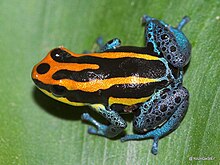Ranitomeya amazonica
Ranitomeya amazonica is a frog. It lives in Peru, Brazil, Colombia, Guyana, and French Guiana. Scientists think it could live in Suriname too.[2][3][1]
| Ranitomeya amazonica | |
|---|---|

| |
| Scientific classification | |
| Domain: | Eukaryota |
| Kingdom: | Animalia |
| Phylum: | Chordata |
| Class: | Amphibia |
| Order: | Anura |
| Family: | Dendrobatidae |
| Genus: | Ranitomeya |
| Species: | R. amazonica
|
| Binomial name | |
| Ranitomeya amazonica (Schulte, 1999)
| |
| Synonyms[2] | |
| |
Home
changeThis frog is awake during the day. It lives lives in rainforests that have never been cut down and in rainforests that have been cut down and have had a long time to grow back. Most of the places this frog lives have not been changed by people, but it can live in some places that people have changed. People have seen this frog between 0 and 200 meters above sea level.[1]
Life
changeThe female frog lays her eggs on bromeliad plants. She lays 2-6 eggs at a time. After the eggs hatch, the male frog carries the tadpoles to other bromeliad plants that have water around their middles. The tadpoles swim in the water and eat algae, dead things, worm-like young of animals with no bones. Sometimes they even eat dead tadpoles, sometimes dead tadpoles of the same species.[1]
Danger
changeScientists believe these frogs are not danger of dying out because it lives in a large place and because there are many of them alive. But it is in some danger because people change the places where it lives to build farms and make places for cows to eat grass. People also catch this frog to sell as a pet. But people also raise captured frogs to sell, so it is not easy to know whether any one pet frog was caught in the forest or not.[1]
Scientists looked at frogs in French Guiana and saw that some of them had the fungus Batrachochytrium dendrobatidis. B. dendrobatidis causes the fungal disease chytridiomycosis, which can kill frogs.[1]
At least two of the places this frog lives are protected parks: Reserva Nacional Alpahuayo Mishana and Reserva Comunal Tamshiyacu-Tahuayo. Scientists think they could live in many more.[1]
References
change- ↑ 1.0 1.1 1.2 1.3 1.4 1.5 1.6 IUCN SSC Amphibian Specialist Group (2023). "Mimic Poison Frog: Ranitomeya amazonica". IUCN Red List of Threatened Species. 2023: e.T55172A85892431. doi:10.2305/IUCN.UK.2023-1.RLTS.T55172A85892431.en. Retrieved June 25, 2024.
- ↑ 2.0 2.1 Frost, Darrel R. "Ranitomeya amazonica (Schulte, 1999)". Amphibian Species of the World, an Online Reference. Version 6.0. American Museum of Natural History, New York. Retrieved June 25, 2024.
- ↑ "Ranitomeya amazonica (Schulte, 1999)". AmphibiaWeb. University of California, Berkeley. Retrieved June 25, 2024.
